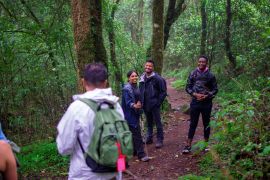
Is Climbing Kilimanjaro Safe? Top Tips for a Successful and Secure Adventure
Climbing Mount Kilimanjaro is an incredible adventure that offers breathtaking views, personal achievements, and memories to last a lifetime. However, many prospective climbers wonder: Is it safe to climb Mount Kilimanjaro? At Serengeti Wildlife Safaris, safety is our top priority, and we’re here to address your concerns, ensuring you’re well-prepared for this extraordinary journey.
From altitude sickness to unpredictable weather, there are risks involved in summiting Africa’s highest peak. By following key safety protocols and proper preparation, your dream of standing on Uhuru Peak (5,895 meters/19,341 feet) can become a reality.
1. Preparation and Planning: The Foundation of a Safe Climb
Fitness and Training
- Why it’s Important: Climbing Kilimanjaro is physically demanding, and adequate fitness is essential to handle long trekking days and steep ascents.
- How to Prepare: Incorporate cardio workouts, strength training, and practice hikes into your routine. Building endurance is critical for high-altitude trekking.
Route Selection
- Choosing the Right Route: Pick a route that matches your fitness level and experience. Longer routes like Lemosho or the Northern Circuit (7–9 days) provide better acclimatization and increase your summit success rate.
- Avoid Rushing: Routes shorter than six days may save time but increase the risk of altitude sickness due to limited acclimatization.
2. Weather Awareness: Preparing for Kilimanjaro’s Unpredictable Conditions
Kilimanjaro’s weather varies dramatically as you ascend through five distinct climate zones, from tropical rainforest to Arctic-like summit conditions.
- Be Prepared for:
- Cold temperatures, especially at night.
- Rain and wind on certain routes during the climb.
- Packing Essentials:
- Layered clothing for warmth and flexibility.
- Waterproof gear, including jackets and pants.
- Insulated gloves, hats, and thermal socks.
At Serengeti Wildlife Safaris, we assist climbers in obtaining essential gear to ensure you’re ready for any weather conditions.
3. Altitude Acclimatization: The Key to Success
Why Acclimatization Matters
Altitude sickness is the biggest safety risk on Kilimanjaro, caused by the body’s inability to adapt to reduced oxygen levels at higher altitudes.
Best Practices for Acclimatization
- Ascend Slowly: Take your time, follow a “climb high, sleep low” strategy, and avoid rushing to the summit.
- Stay Hydrated: Drink at least 3 liters of water daily to support your body’s adjustment.
- Monitor Symptoms: Look out for headaches, nausea, fatigue, or dizziness. If symptoms worsen, descend immediately.
4. Health and Medical Considerations
Altitude Sickness: Recognizing and Managing Risks
- Symptoms to Watch For: Headaches, nausea, dizziness, and shortness of breath.
- What to Do: Inform your guide immediately if symptoms appear. Guides with Serengeti Wildlife Safaris are trained to monitor your condition and provide oxygen or assistance if needed.
Pre-Climb Medical Check-Up
- Get Cleared for Climbing: Visit your doctor to ensure you’re in good health, especially if you have pre-existing conditions like asthma, diabetes, or heart problems.
Medication and First Aid
- Carry essential medications, including:
- Acetazolamide (Diamox): To prevent and manage altitude sickness.
- Pain relievers and anti-diarrheal medicine.
- Personal prescriptions for chronic conditions.
- Guides with Serengeti Wildlife Safaris also conduct daily health checks, including oxygen level and heart rate monitoring.
5. Trusted Guides: Your Safety Partners on Kilimanjaro
Experienced and certified guides are essential for a safe climb. At Serengeti Wildlife Safaris, our professional guides:
- Provide expert advice on pacing and acclimatization.
- Conduct daily health checks to monitor your well-being.
- Ensure your safety during emergencies, including organizing descents if necessary.
6. Environmental and Cultural Considerations
Respecting the Environment
Kilimanjaro is a UNESCO World Heritage Site, and preserving its ecosystem is essential. Follow these Leave No Trace principles:
- Pack out all waste, including food wrappers and bottles.
- Stick to designated trails to minimize erosion.
Cultural Etiquette
Engage respectfully with local guides and porters. Their expertise and cultural knowledge enhance your Kilimanjaro experience. Serengeti Wildlife Safaris values ethical tourism and fair treatment of porters.
Conclusion: Your Safe Ascent to the Roof of Africa
Climbing Mount Kilimanjaro is a thrilling, life-changing journey—but safety must always come first. By focusing on adequate preparation, health monitoring, acclimatization, and trusted guidance, you can reduce risks and enjoy a successful summit.
At Serengeti Wildlife Safaris, we prioritize your safety and support every step of the way, ensuring you have an unforgettable and secure adventure.
Ready to Begin Your Journey?
Contact Serengeti Wildlife Safaris today to start planning your Kilimanjaro adventure. With our expertise and commitment to safety, your dream of standing atop Africa’s highest peak is closer than you think!
